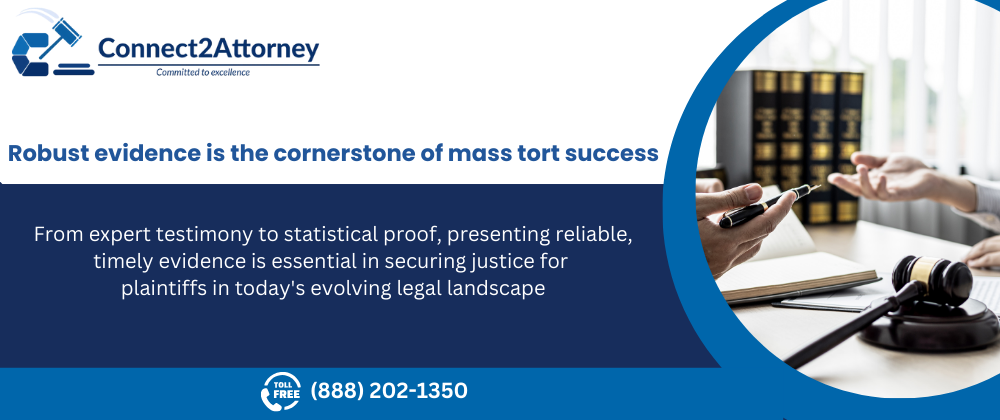Winning with Evidence: The Backbone of Mass Tort Success

Mass tort litigation serves as a powerful tool for individuals seeking justice against corporations or entities that have caused harm through negligence or wrongdoing. Evidence is a fundamental component of these cases. A well-crafted mass tort claim hinges on robust evidence that can substantiate claims and sway juries. Understanding how to gather and present this evidence effectively can make the difference between victory and defeat.
The Importance of Evidence in Mass Tort Litigation
Evidence forms the backbone of mass tort cases. It serves to establish the facts of the case, demonstrating that a wrongful act occurred and that it resulted in harm to individuals. The types of evidence required can vary significantly depending on the nature of the tort but generally fall into several categories:
- Documentary Evidence: This includes official records, emails, internal communications, product manuals, and anything that can shed light on the actions of the defendant. For instance, documentation showing safety inspections or lack thereof can be pivotal in proving negligence.
- Witness Testimonies: Eyewitness accounts from those directly affected can provide compelling narratives. When multiple witnesses share similar experiences, it strengthens the overall case.
- Expert Testimony: Experts in fields relevant to the case can clarify complex issues for juries. Their insights into safety standards, medical implications, or engineering failures can help to establish causation and negligence.
- Physical Evidence: This refers to tangible items related to the tort, such as defective products. Demonstrating the flaws or risks associated with a product can significantly bolster a case.
- Statistical Evidence: Demonstrating patterns through statistical analysis can underscore the severity of the issue. For example, statistics showing a high incidence of injuries related to a specific product can establish a compelling argument for liability.
Evidence Collection for Mass Tort Lawsuits
The evidence collection process involves several stages, each requiring careful consideration:
Identify Key Evidence Types
Determining what types of evidence will support the case is essential. This involves assessing the nature of the tort, the defendants involved, and the specific allegations being made.
Develop a Document Request
Creating a document request tailored to the specifics of the case is crucial. This should outline the types of documents being sought from the defendants, including internal communications, reports, and relevant records.
Interview Witnesses
Conducting interviews with potential witnesses should be prioritized. This not only helps in gathering testimonies but also serves to establish relationships with individuals who may be pivotal to the case.
Preserve Evidence
Implementing strategies for evidence preservation is vital. This includes securing physical evidence, making copies of documents, and storing digital evidence in secure locations. Failure to preserve evidence can lead to challenges in court, including spoliation claims.
Collaborate with Experts
Engaging experts early in the process can provide insights into the evidence needed. For instance, if the case involves medical malpractice, securing a medical expert’s input can guide the collection of relevant medical records and testimonies.
Legal Evidence in Mass Tort Success
Legal evidence must meet specific standards to be admissible in court. This includes relevance, reliability, and authenticity. Courts typically employ strict rules regarding the admissibility of evidence. Understanding these rules can significantly enhance the effectiveness of a mass tort case. Here are some considerations:
- Relevance
All evidence presented must be relevant to the claims being made. This means that it must have the potential to influence the outcome of the case. Legal teams should carefully assess how each piece of evidence ties into the overall narrative.
- Reliability
Reliability refers to the trustworthiness of the evidence. This is particularly important for witness testimonies and expert opinions. Courts often scrutinize the qualifications of experts and the methodologies used to obtain evidence.
- Authenticity
Evidence must be proven to be authentic. This can involve presenting documentation that verifies the source of the evidence or establishing a clear chain of custody. This ensures that the evidence has not been tampered with or altered in any way.
Recent Developments in Evidence Handling
- Adoption of E-Discovery Tools: As of September 2023, 75% of legal professionals use e-discovery tools to manage large volumes of digital evidence in mass tort cases, a sharp rise from 60% in 2022. E-discovery tools have become integral in expediting the identification, organization, and review of key documents, emails, and communications.
- Evidence Preservation Guidelines: In August 2023, the American Bar Association (ABA) updated its evidence-handling guidelines for mass tort cases, emphasizing the need for early evidence preservation. This update highlights that delays in preserving digital and physical evidence can lead to spoliation claims, which can weaken the plaintiff’s case.
- Rise in Mass Tort Litigation: According to the National Center for State Courts (NCSC), there has been a 15% increase in mass tort filings in 2023, particularly in cases related to defective medical devices and pharmaceutical products. This rise has underscored the importance of strong statistical and documentary evidence in establishing corporate negligence and liability.
- Use of Statistical Evidence: In 2023, 80% of mass tort cases utilized statistical evidence to demonstrate patterns of harm. For example, a recent case involving a pharmaceutical company used injury rate statistics to show that 35% of users experienced side effects, which was pivotal in securing a favorable settlement.
Proof in Mass Tort Cases
Proof in mass tort cases encompasses the establishment of liability and damages. This involves demonstrating that the defendant’s actions directly caused harm to the plaintiffs. Gathering sufficient proof can take many forms:
- Establishing Causation: Linking the defendant’s actions to the harm suffered by plaintiffs is critical. This often requires expert testimony to clarify complex relationships.
- Quantifying Damages: Presenting evidence of damages involves detailing the financial, physical, and emotional impact on plaintiffs. Documentation of medical expenses, lost wages, and emotional distress can provide compelling proof.
- Demonstrating Pattern and Practice: Evidence showing a pattern of misconduct can strengthen a case. For example, if a company has a history of similar incidents, it establishes a precedent that can bolster claims of negligence.
The Path to Mass Tort Success
Successfully navigating mass tort litigation relies heavily on effective evidence collection and presentation. Legal professionals must prioritize thorough preparation, leverage technology, and uphold ethical standards to enhance their chances of success.
If you need legal representation in a mass tort case or want to learn how Connect2Attorney can help, visit their website for more information. Their expertise in connecting clients with qualified attorneys ensures you receive the best support for your legal journey.
Staying informed about developments in the legal field is crucial for achieving favorable outcomes.








